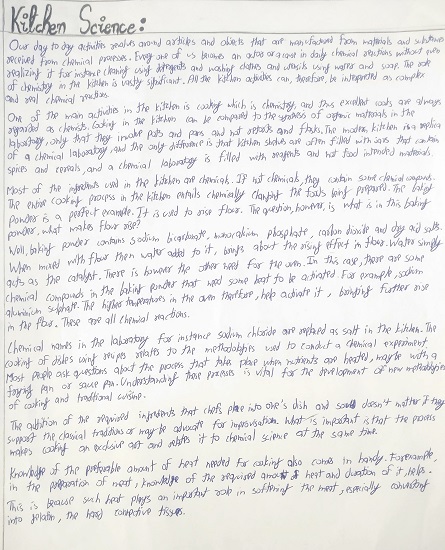
Group A : 11 to 13 years
Kitchen Science Essay
by Shivam Jha
Vivekananda Kendra Vidyalaya, Arunachal Pradesh
This children’s essay competition was conducted by Khula Aasmaan and Science Park, Pune

Group A : 11 to 13 years
Kitchen Science Essay
by Shivam Jha
Vivekananda Kendra Vidyalaya, Arunachal Pradesh
This children’s essay competition was conducted by Khula Aasmaan and Science Park, Pune
Our day to day activities revolves around articles and objects that are manufactured from materials and substances received from chemical processes. Every one of us becomes an actor or a cause in daily chemical reactions without even realizing it for instance cleaning using detergents and washing clothes and utensils using water and soap. The role of chemistry in the kitchen is vastly significant. All the kitchen activities can, therefore, be interpreted as complex and real chemical reactions.
One of the main activities in the kitchen is cooking which is chemistry and thus excellent cooks are always regarded as chemists. Cooking in the kitchen can be compared to the synthesis of organic materials in the laboratory, only that they involve pots and pans and not retorts and flasks. The modern kitchen is a replica of a chemical laboratory and the only difference is that kitchen shelves are often filled with jars that contain spices and cereals and a chemical laboratory is filled with reagents and not food intended materials.
Most of the in ingredients used in the kitchen are chemicals. If not chemicals, they contain some chemical components. The entire cooking process in the kitchen entails chemically changing the foods being prepared. The baking powder is a perfect example. It is used to rise flour. The question, however is, what is in this baking powder, what makes flour rise?
Well, baking powder contains sodium bicarbonate, monocalcium phosphate, carbon dioxide and dry acid salts. When mixed with flour then water added to it, brings about the rising effect in flour. Water simply acts as the catalyst. There is however the other need for the oven. In this case, there are some chemical compounds in the baking powder that need some heat to be activated. For example, sodium aluminium sulphate. The higher temperatures in the oven therefore, heat activate it, bringing further rise in the flour. These are all chemical reactions.
Chemical names in the laboratory for instance sodium chloride are replaced as salt in the kitchen. The cooking of fishes using recipes relates to the methodologies used to conduct a chemical experiment. Most people ask questions about the process that takes place when nutrients are heated, may be with a frying pan or sauce pan. Understanding these process is vital for the development of new methodologies of cooking and traditional cuisine.
The addition of the required ingredient that chefs place into one’s dish and soup doesn’t matter, if they support the classical traditions or may be advocate for improvisation. What is important is that the process makes cooking an exclusive art and relates it to chemical science at the same time.Knowledge of the preferable amount of heat needed for cooking also comes in handy. For example, in the preparation of meat, knowledge of the required amount of heat and duration of it, helps. This is because such heat plays an important role in softening the meat, especially converting into gelatin, the hard connective tissues.
Listen to "Kitchen Science", essay by Shivam Jha
(Narrated by Akshita Rajeshwar)
Video presentation of essay on "Kitchen Science" by Shivam Jha
(Narrated by Akshita Rajeshwar)
Read science & technology blog
Khula Aasmaan conversations audios
Science related audios on Soundcloud